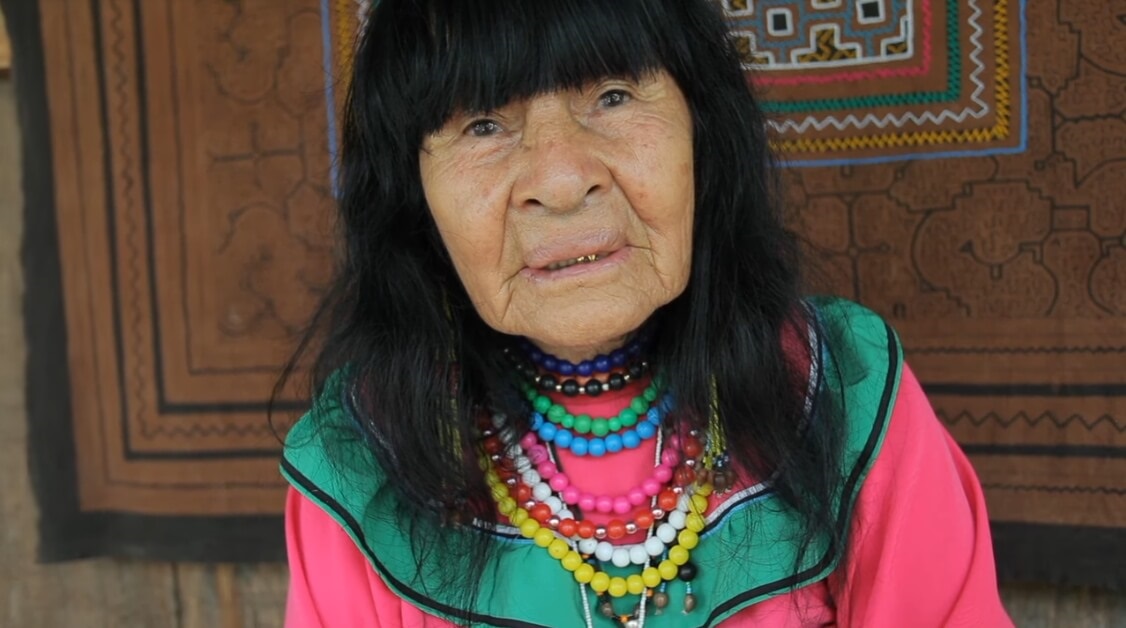
by Deep Green Resistance News Service | May 16, 2018 | Colonialism & Conquest
by Sebastián Ortega and Jhonny Valle Ayuque / openDemocracy via Intercontinental Cry
Leader of the Shipibo-konibo community, Olivia Arévalo Lomas, was 81 years old when she was shot in the chest and murdered. The principal suspect, Canadian Paul Woodroffe, died a few hours later.
The leader, practitioner of traditional medicine and defender of the Peruvian Amazon, Olivia Arévalo Lomas, of Shipibo-konibo ethnicity, was 81 years old when she was murdered last Thursday by two 380 calibre shots to the chest.
The main suspect, Canadian Paul Woodroffe died shortly after: a group of community members dragged him through the streets and beat him to death.
Olivia was a known shaman of Victoria Gracia, an intercultural settlement in the district of Yarinacocha. “Her death is an aggression against the entire Shipibo community. She was the living memory of her people” explained Juan Carlos Ruíz Molleda, coordinator of the department of indigenous communities and constitutional litigation of the NGO Institute of Legal Defence.
THE DAY THAT THEY MURDERED OLIVIA, ANOTHER WOMAN FROM THE SHIPIBO COMMUNITY, MAGDALENA FLORES AGUSTÍN, RECEIVED AN ANONYMOUS ENVELOPE AT HER HOME. INSIDE THERE WERE TWO BULLETS AND A LETTER DIRECTED TO HER AND HER HUSBAND.
It was not only members of her own Shipibo community, a village of more than 35,000 people that inhabit the amazon rainforest of Peru that turned to the guardian. She also attended to dozens of tourists who sailed for more than 15 hours down the river Ucayali to cure themselves of illnesses and to treat addictions.
“She was a grandmother who worked with medicinal plants”, Wilder Muñoz Díaz told Cosecha Roja, a traditional Shipibo doctor from a nearby community that shared healing ceremonies with Olivia. “It was very painful for us finding about her death”, he added.
Despite the main leads regarding the crime having discarded the possibility it might have been a political crime, indigenous communities have remained on alert.
The murder of the Amazonian guardian occurred in a context of territorial conflict between the Shipibo community and companies that desire to take over their land to cultivate palm oil.
The exploitation of the Peruvian amazon “affects the subsistence” of every community within the region explains Ruíz Molleda. They contaminate rivers where people wash themselves and fish, and they destroy the land in which the animals they hunt live.
In the past few years, around 6000 hectares of rainforest were deforested by companies who were operating illegally.
“The communities don’t want to sell their lands and that’s when hitmen start appearing”, according to Ruíz Molleda. In 2013 Mauro Pío Peña, historic leader of the Ashaninka community, was murdered by two hitmen.
The following year, Edwin Chota Valera, Leoncio Quintisima Meléndez, Francisco Pinedo Ramírez and Jorge Ríos Pérez, leaders from the Ashaninka community, were also murdered.
The suspicions point to wood extraction entrepreneurs that illegally exploit the amazon rainforest and drug traffickers who had threatened them. In 2015, other leaders and members of the Shipibo community of Santa Clara de Uchunya were threatened.
The day that they murdered Olivia, another woman from the Shipibo community, Magdalena Flores Agustín, received an anonymous envelope at her home. Inside there were two bullets and a letter directed to her and her husband: “you have 48 hours to leave here. One bullet for each of you”.
The investigators of the crime are following two leads: according to the first version, on the 19th of April the Canadian Woodroffe arrived at Olivia’s house by motorbike. When she left to go to the shops he shot her twice in the chest.
Two days later the police found the body of the Canadian buried on their terrain. They arrived there after discovering a video on social media in which several men can be seen lynching Woodroffe.
The investigators suspect that the neighbours of the leader caught him when he tried to escape and they dragged him with a rope around his neck whilst they beat him. Yesterday, the Supreme Court of Justice of Ucayali ordered the capture of the two men who appear in the video.
“What happened with the supposed suspect of the murder of Olivia Arévalo is not indigenous justice and it has nothing to do with it” explained Ruíz Molleda.
The Peruvian constitution establishes that the authorities within indigenous and rural communities may carry out justice in their own territory according to their customs. “But always with respect for human rights”, explained the lawyer of the NGO Legal Defence.
The Shipibo Konibo Xetebo Council (Coshicox), the highest authority within the Shipibo – Konibo – Xetebo community, condemned the crime and declared that justice is compatible with indigenous culture.
The Federation of Native Communities of Ucayali and Alfluentes (Feconau) also asked the state to provide guarantees to other indigenous leaders that receive death threats and harassment.
This article was originally published at OpenDemocracy and re-published at IC under a Creative Commons License.

by Deep Green Resistance News Service | Mar 16, 2018 | Repression at Home
Featured image: Marielle Franco speaking at a campaign rally in Rio de Janeiro, Brazil in 2016. Photo: Mídia Ninja/Flickr CC BY-SA 2.0
by Fernanda Canofre / Global Voices
Less than two hours before she was murdered on the evening of March 14, Rio de Janeiro city councillor Marielle Franco was speaking at a roundtable of black women activists about “young black women moving the structures.”
As Franco was leaving the site, a car pulled up to the side of her own vehicle and fired nine shots into it. Franco and her driver, Anderson Pedro Gomes, were killed on the spot. The councillor’s press officer, who was in the backseat, was hit by glass fragments and injured but survived.
Bearing all the hallmarks of an execution, the attack has sent shockwaves through Brazil including social media. Nationwide protests have been scheduled for the next couple of days. More than 70,000 people and organisations have confirmed their presence in the demonstration in Rio de Janeiro.
Marielle Franco was elected with the leftist Socialist and Freedom Party (PSOL) in 2016 as the fifth most voted councillor in Rio de Janeiro, Brazil’s second-largest city with a population of over six million.
As a young, black, favela-bred lesbian woman activist, she championed several underrepresented demographics in Brazil’s institutional politics and was beloved by activists across the country.
Remembering a fierce critic and activist
Marielle Franco was born and raised in the Maré favela, the largest complex in Rio and home to 130,000 people. In 2005, Franco’s best friend was killed there during a confrontation between police officers and drug dealers. That episode drove her into human rights advocacy and activism against police violence.
A fierce critic of Rio’s deadly police, she had been appointed in late February 2018 as the main rapporteur for the commission of Brazil’s municipal assembly to monitor the ongoing army intervention in Rio de Janeiro.
Brazil’s army took over the city’s public security in early February in response to gang violence despite criticism from local non-governmental organizations and the United Nations’ Human Rights Council.
She had openly criticized the intervention and compared it to a similar operation in her native Maré favela during the 2014 World Cup.
Franco consistently spoke out, both from the pulpit and on her social media pages, against extrajudicial killings of Rio’s poor and mostly black favela residents.
Just this week, she made a series of posts on Facebook about the ongoing violence in the Acari favela:
This week, two young men were killed and dumped at a hole. Today, the police were walking through the streets threatening residents.
Franco called attention to a news story that reported five shoot-outs in the favela over the course of seven days:

Marielle last Facebook post was about the ongoing police violence in Acari favela. Photo: Screenshot/Facebook
Franco spoke out against Brazil’s lethal police
Police lethality in Brazil is staggering. In 2016, 920 killings by police were documented in Rio de Janeiro alone, up from 419 in 2012, according to Amnesty International. A report by Public Security Forum, a national research institution, counted 4,224 killings by police officers in the whole country in 2016, with 99 percent of them being men and 76 percent black. Many of those homicides may amount to extrajudicial killings, a crime under international law.
On social media, organisations, political parties and civil profiles used hashtags asking for a throughout the investigation of Franco’s murder.
The Feminist Network of Jurists stated on Facebook:
Her political importance goes beyond the direct actions to combat violence suffered by black people from Rio. Marielle, while a black woman, represented millions of women without a political voice within the State, breaking a pact of exclusion of black people crystalized by the history of segregation in Brazil, masked by the myth of racial democracy.
Amnesty International‘s Brazil chapter also demanded an investigation:
There should not be any doubts about the context, motivation, and authorship of Marielle Franco’s murder.
Her party PSOL issued an official statement saying that the hypothesis of a “political crime” could not be discarded, since “she had just denounced a brutal action” by the police.

Marielle Franco grew up at Maré Complex, the largest favela in Rio de Janeiro. Photo: Mídia Ninja CC BY-SA 2.0
“We cannot wait another 10 years or think that I will be there for another 10”
Sociologist and public security specialist Luiz Eduardo Soares, a close friend to Franco, remembered how the attack echoes that of Judge Patricia Acioli, also killed in a drive-by shooting in 2011. Accioli had been overseeing a number of cases involving paramilitary groups (called ‘militias’ in Rio).
When, my god, will the people awake and understand that public unsafety starts at the most corrupt and brutal segments inside police forces, and that we cannot live with this haunting legacy from the dictatorship period anymore. Will we continue to talk about ‘individual misconduct’? What can we do now, besides crying?
During the black activists’ roundtable that Franco had joined hours before being killed, she said:
We have a movement pushing for more women in politics, in power positions, more women occupying decision making spots, because that is the only way of getting more qualified public policies.
Franco remembered two black women politicians who had come before her, ten years apart from each other, urging:
We cannot wait another 10 years or think that I will be there for another 10.

by DGR News Service | Mar 6, 2018 | Biodiversity & Habitat Destruction, Obstruction & Occupation
by Wild Buffalo Defense
Media Contact: Talon BringsBuffalo, 646-352-2126
An hour before sunlight on march 5th two members of the Wild Buffalo Defense collective named Cody and Crow descended from the hills onto Yellowstone National Park’s Stevens Creek buffalo trap and using a steel pipe, locked themselves to the bars of the “Silencer”, a hydraulic squeeze shoot that holds buffalo for testing, shipping and slaughter. In freezing temperatures the individuals blocked the buffalo processing facility and prevented the park from shipping wild buffalo to slaughter.
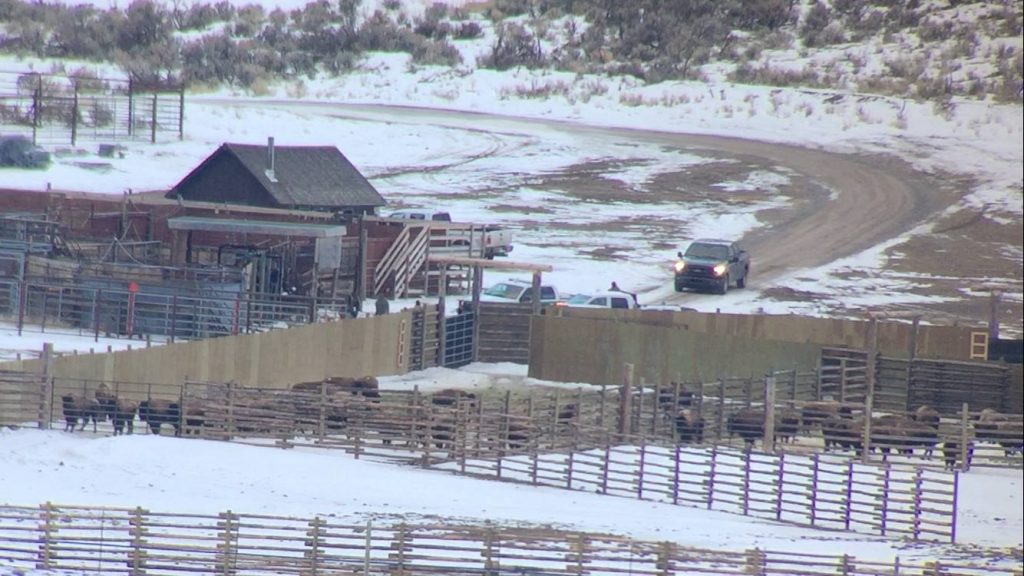 When asked why he was taking this action Cody stated, “I am standing with the plains Indians as a member of the Ojibwe tribe in Minnesota, I have a Blackfeet friend who helped me protect my territory from the line 3 pipeline and now I am here for him and the buffalo. I have a love for the people. That’s what my mom passed down to me. And I have love for the environment and animals and I feel like I have an obligation to protect them. If I have to put my body on the line to do so I will.”
When asked why he was taking this action Cody stated, “I am standing with the plains Indians as a member of the Ojibwe tribe in Minnesota, I have a Blackfeet friend who helped me protect my territory from the line 3 pipeline and now I am here for him and the buffalo. I have a love for the people. That’s what my mom passed down to me. And I have love for the environment and animals and I feel like I have an obligation to protect them. If I have to put my body on the line to do so I will.”
The two Yellowstone buffalo herds are the last free ranging, genetically pure, plains buffalo in the United States. These buffalo are decedents of the 23 that survived the buffalo extermination campaign that the US government implemented in the 1800s to starve the plains Indians into submission.
Today the Stevens Creek Buffalo Trap costs the Yellowstone Parks Service 3 million dollars per year to maintain and despite years of public opposition continues to operate their capture-for-slaughter facility within the park boundary. Activists and tribes allege that the Montana cattle lobby controls how the Parks Service manages of the wild buffalo. Crow, the other individual who locked himself to the facility stated “They say they need to kill the animals to stop the spread of Brucellosis, but the wild elk have Brucellosis and they are allowed to roam free because the cattle industry is not worried about elk competing for grass and the state receives income from the elk hunting permits.” Every year the facility captures and sends roughly 1000 animals of the 4000 wild buffalo population to slaughter.
While the two individuals locked themselves to the shoot, some activists gathered at the gate of the facility with banners reading “Wild buffalo slaughter = cultural genocide.” Their signs spoke to the connection between the culture of the plains tribes and the wild buffalo, suggesting that by exterminating the last wild buffalo, Yellowstone is effectively attempting to do the same to the culture of the plains tribes. The non-violent direct action came in the wake of a decision by the Montana department of livestock and the animal plant and health inspection service to deny the Fort Peck Indian reservation the right to receive wild buffalo from the park.
To Support Wild Buffalo Defense please contribute to our campaign and legal fund!
Campaign Fund: https://www.youcaring.com/wildbuffalodefense-1119076
Legal Fund: https://www.youcaring.com/wildbuffalodefense-1119210
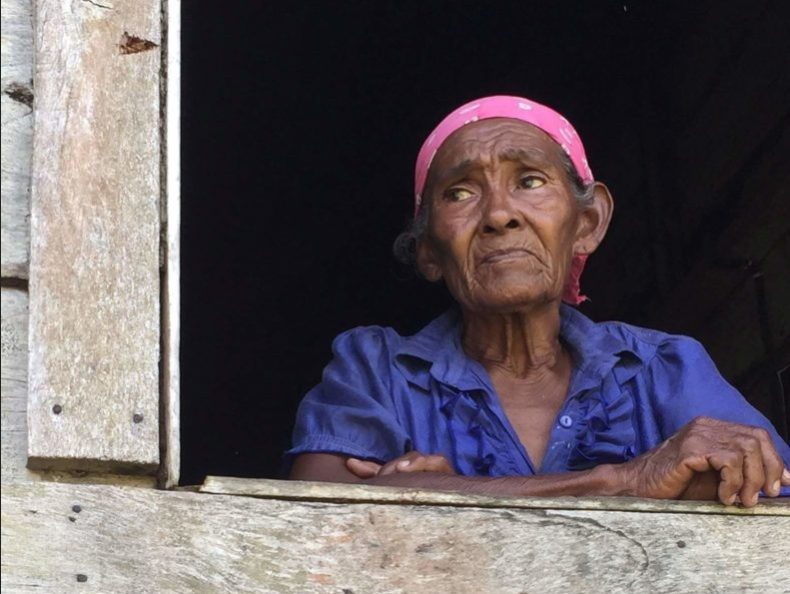
by Deep Green Resistance News Service | Jul 18, 2017 | Repression at Home
Featured image: A Miskito elder stands watch in what has become a daily vigil – awaiting the promised return of armed Colonos who recently attacked her village with sophisticated weaponry, covering her home in bullet holes and terrorizing the Miskito community. Courtney Parker, 2016
by Courtney Parker / Intercontinental Cry
Recently published statistics from watchdog group, Global Witness, have confirmed what Indigenous Nicaraguans have been trying to tell the world for years – the battle to protect Indigenous land rights in Nicaragua is not just one of the most dangerous…it is the most deadly.
Faced with such mounting evidence, however, the global human rights community continues to shrug its shoulders.
A recent article lauding a new partnership between The Guardian and Global Witness – aimed at increasing surveillance and reporting on land activists’ deaths worldwide – bizarrely blacks out a single mention of Nicaragua, which emerged from recent analysis as the deadliest nation in the world for land rights struggles, per capita.
The Guardian’s omission is glaring, as the authors specifically call out conditions in countries such as Colombia, the United States, Brazil, Honduras, and Mexico. They avoided even naming Nicaragua, which has a higher death rate for land activists than any of these regions. Even more disturbing, such deaths in Nicaragua remain grossly underreported still, due to the relative isolation of high conflict zones such as the northern Caribbean coast.

Women from the community of Santa Clara gather to denounce the violence inflicted by the encroaching illegal land settlers. The woman in the center describes the unthinkable; her daughter (in the yellow shirt) was shot in the head by colonos during one such horrific attack. Photo: Courtney Parker, 2016
There are hints the authors sought to, by excluding the socialist country, frame the escalating crisis in a thematic, but ultimately myopic, critique of capitalism – which could perpetuate a popular (sometimes populist) false narrative that socialism (or Marxism) is some sort of vaccine against environmental exploitation. Regardless of intent, such implications could not be less true.
A few cases in point…
The great socialist nation of Canada – even with human rights superstar, Justin Trudeau, now at the reigns – continues its deadly, imperialist, extractivism activity in Latin America, and remains a driving force behind the controversial and potentially devastating oil pipelines to the north. An imperialist Chinese mining operative has waged violent attacks against Indigenous community defenders with direct support from the military in Ecuador – a country once famous for their groundbreaking constitution codifying the ‘Rights of Nature’. Nicaragua, meanwhile, is busy destroying the second largest tropical rainforest in the western hemisphere in attempts to sustain the oft praised ‘era of economic growth’ under Daniel Ortega.
Subhabrata ‘Bobby’ Banjeree’, a professor of the University of London’s Cass Business School, provided some insight about media inconsistencies on land rights struggles through a statement to the Thomas Reuters Foundation (concerning the Global Witness report.)
“Right now there are more than 2,000 reported hotspots around the world. The reality is that there are probably three times that number which are not reported because they are not as sexy and don’t make TV news.”
As The Guardian attempts to take the lead on resolving the disparities in coverage, it has somehow found cause to preemptively omit the deadliest case. One is left to wonder if calling out so-called capitalist nations is in fact sexy, and hard evidence which might dilute this motif is somehow…not.

The tombs of two community heroes in Santa Clara – acclaimed Miskitu warriors who sacrificed their lives attempting to shield their families and friends from encroaching violence – are displayed in reverence at a central point in the village.. Photo: Courtney Parker, 2016
In an insight especially relevant to Nicaragua, Banjeree also noted to Reuters how the role of the state is often compromised by conflicting responsibilities in encouraging economic development for a given nation and protecting the citizens who live there. The ostensibly ‘Christian-socialist’ government of President Ortega seems to be repeatedly and incomprehensively erring on the side of violence and neoliberal economics.
Global Witness itself has emerged as a truly objective watchdog group in an ideologically tainted atmosphere of human rights activism, in which various struggles are routinely ennobled or suppressed according to how well they fit into ongoing narratives supporting capitalist or anti-capitalist fervor. In their own statement about the new Guardian partnership, Global Witness conveyed:
“We’re hoping this will help break the silence that fuels this rising tide of violence. Many activists who are murdered live in remote villages deep within rainforests or mountain ranges, and their deaths pass under journalists’ radars. Without the exposure that comes from media coverage, governments and businesses have fewer incentives to protect people under threat, or to punish perpetrators. “
Their clearly defined goal gives cause to remain optimistic that commitment to truth and transparency will guide and reorient coverage generated through their partnership with The Guardian – though things are not off to an encouraging start.
To their credit, The Guardian has featured other coverage on the struggle for Indigenous land rights in Nicaragua, such as this piece from March of this year. While fairly comprehensive, the article still preserves a certain aura of credulity, a benefit of the doubt, in regard to the underlying intentions of Daniel Ortega and the ruling party of the FSLN – a credulity, that is facing regional extinction in Moskitia with the escalating murders of Indigenous Miskitos at the hands of ‘Colonos’ (armed invaders who have placed the autonomous Indigenous nation of Moskitia under a violent siege while FSLN militarized police routinely look the other way.)
It is high time to embrace, what is for many, a painful and perhaps counterintuitive truth. The differences between socialism and capitalism, regarding environmental justice and environmental exploitation, have proven slim to none. And nowhere is this demonstrated more clearly than in the nation of Nicaragua, currently under socialist rule by the once dogmatically Marxist Sandinista. Quasi-intellectual dogma and calcified political ideologies are not going to save the Earth or protect its most dedicated defenders. Hence, it is time we get realistic in attempting to discern what will.
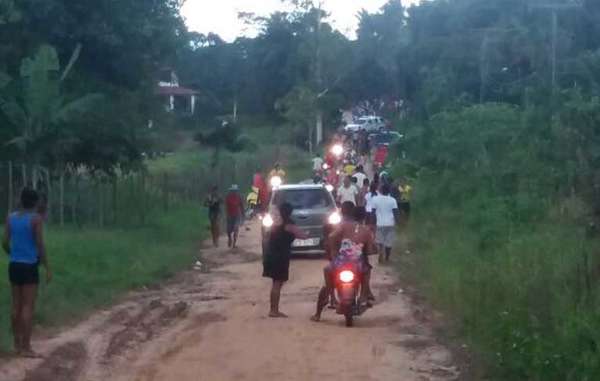
by Deep Green Resistance News Service | May 4, 2017 | Colonialism & Conquest
Featured image: Cellphone photo shows the ranchers on their way to attack the Gamela. A police car accompanies them. © CIMI
by Survival International
Warning: Graphic photos
Thirteen Brazilian Indians have been hospitalized after a brutally violent attack by men armed with machetes in the Amazon.
One man appears to have had his arms severed in disturbing photos released to Survival International.
The attack was in retaliation for the Gamela Indians’ campaign to recover a small part of their ancestral territory. Their land has been invaded and destroyed by ranchers, loggers and land grabbers, forcing the Gamela to live squeezed on a tiny patch of land. The Gamela are indigenous to the area in Maranhão state in northern Brazil.
Powerful agribusiness interests – reportedly including the Sarney landowning family – have been in conflict with the tribe for some time. The family includes a former president of Brazil and a former governor of Maranhão state.
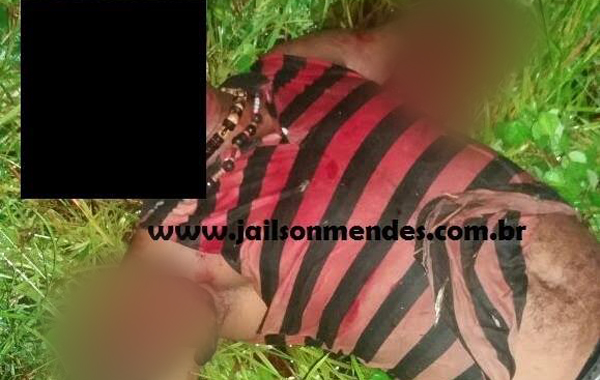
Photo of a victim of the attack, sent to Survival by Brazilian NGO CIMI. © CIMI
Eyewitnesses say that the ranchers gathered at a barbecue to get drunk, before surrounding the Gamela camp, firing guns, and then attacking with machetes, causing grievous injuries. Local police are reported to have stood by and allowed the attack to happen.
The Gamela have received death threats in response to their attempts to return to their land. In a declaration released by Brazilian NGO CIMI, they said: “People are mistaken if they think that by killing us they’ll put a stop to our fight. If they kill us, we will just grow again, like seeds… Neither fear nor the ranchers’ bullets can stop us.”
The attack came just days after massive indigenous protests in Brazil’s capital against proposed changes to Brazil’s indigenous laws, which could have disastrous consequences for tribal peoples.
Land theft is the biggest problem tribal peoples face. Around the world, industrialized society is stealing tribal lands in the pursuit of profit.
Campaigners fear that the close ties between Brazil’s agribusiness lobby and the Temer government installed after the impeachment of Dilma Rousseff in 2016 could lead to further genocidal violence and racism against Brazilian tribal peoples.
Survival’s Director Stephen Corry said: “Right now, we’re witnessing the biggest assault on Brazilian Indians for the last two generations. This truly horrific attack is symptomatic of a sustained and brutal onslaught which is annihilating indigenous communities across the country. Heinous acts like this won’t end until the perpetrators are prosecuted and Brazil starts enforcing tribal land rights as it should do under national and international law.”











